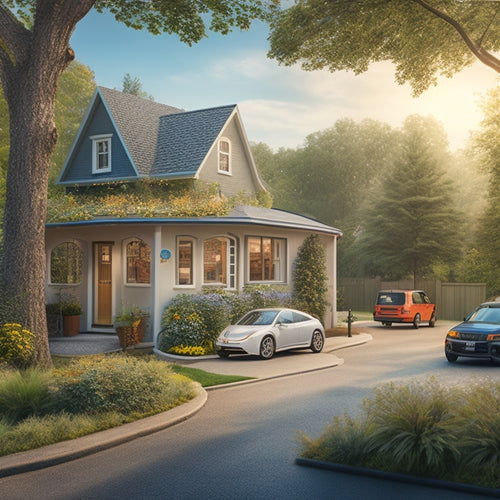
Installing Solar Panels on Your House in 5 Steps
Share
You'll start by evaluating your home's solar potential, ensuring it receives the required 4-5 hours of direct daily sunlight. Next, you'll choose the right solar panel system, balancing energy needs, roof size, and local building codes. Prepare your roof and home by inspecting for damaged shingles, clearing debris, and sealing gaps to prevent heat loss. A professional will then install the system, connecting panels to an inverter and monitoring system. Finally, you'll connect to the grid and monitor your energy production and consumption, optimizing your usage to maximize savings - and that's just the beginning of your solar expedition.
Key Takeaways
- Assess your home's solar potential by evaluating roof orientation, size, and sunlight exposure to determine the optimal solar panel system.
- Choose the right solar panel system based on energy needs, roof size, and local building codes, considering panel types, inverters, and budget.
- Prepare your roof and home by inspecting and maintaining the roof, clearing debris, and ensuring energy efficiency to maximize energy savings.
- Install the solar panel system, including mounting, connecting panels to an inverter, and monitoring energy production and consumption.
- Connect to the grid and monitor your system to optimize energy usage, offset consumption during non-sunny periods, and enhance grid integration.
Assess Your Home's Solar Potential
Your house receives sunlight, but is it enough to justify installing solar panels? To assess your home's solar potential, consider the amount of direct sunlight your roof receives daily. Ideally, your roof should get at least 4-5 hours of direct sunlight per day. Shading from trees, buildings, or other obstructions can greatly reduce solar energy benefits.
Next, evaluate your roof orientation. A south-facing roof is ideal, as it receives the most direct sunlight throughout the day. East- and west-facing roofs can also work well, but north-facing roofs are less suitable.
Additionally, consider the roof's pitch and size. A larger, steeper roof can accommodate more solar panels, increasing energy production.
Assessing your home's solar potential helps determine the feasibility of installing solar panels. By understanding the amount of sunlight your roof receives and its orientation, you can make an informed decision about investing in solar energy.
With the right conditions, you can utilize the power of the sun and enjoy the solar energy benefits, including reduced energy bills and a smaller carbon footprint.
Choose the Right Solar Panel System
Selecting a solar panel system that suits your needs and budget is crucial for maximizing your energy savings.
You'll want to take into account various solar panel types, each with its own benefits and drawbacks. Monocrystalline panels offer high energy efficiency, but are more expensive. Polycrystalline panels are more affordable, but slightly less efficient. Thin-film panels are the most budget-friendly option, but have lower energy efficiency.
When choosing a system, reflect on your energy needs, roof size, and local building codes. Look for systems with high-efficiency panels, as they'll generate more power per hour of sunlight. You'll also want to confirm the system is compatible with your existing electrical infrastructure.
Additionally, weigh the inverter type. String inverters are the most common, but microinverters offer more flexibility and monitoring capabilities.
Prepare Your Roof and Home
Now that you've chosen the right solar panel system, it's time to confirm your roof and home are ready for installation. Start by inspecting your roof's condition, checking for damaged, missing, or loose shingles, and verifying it's structurally sound.
Perform any necessary roof maintenance, such as repairing or replacing shingles, to prevent water damage or leaks during installation. Clear your roof of debris, including leaves and branches, to guarantee a safe and efficient installation process.
Next, assess your home's energy efficiency by checking for air leaks, insulation, and window condition. Seal any gaps or cracks to prevent heat loss and optimize your home's energy consumption.
This will help your solar panel system work more efficiently and effectively. Additionally, consider upgrading to energy-efficient appliances and lighting to maximize your energy savings.
Install the Solar Panel System
With the roof and home prepared, it's time to bring in the professionals to install your solar panel system. They'll assess your energy needs and determine the best solar panel types for your situation, considering factors like your energy usage, roof size, and local building codes.
The installation team will then start by installing the mounting system, which securely fastens the solar panels to your roof.
Next, they'll connect the solar panels to an inverter, which converts the DC power generated by the panels into AC power that's usable in your home. The team will also install a monitoring system to track your energy production and consumption.
Installation costs vary depending on the size and complexity of your system, but on average, you can expect to pay between $2.50 and $3.50 per watt.
For a typical residential system, this works out to around $15,000 to $20,000. While it's a significant upfront investment, the long-term savings on your energy bills and potential increase in your home's value make it a worthwhile choice.
Connect to the Grid and Monitor
Through a process called net metering, your solar panel system connects to the grid, allowing you to feed excess energy back into the electrical grid and offset your energy consumption when the sun isn't shining. This grid integration enables you to maximize your energy savings and reduce your reliance on traditional power sources.
To monitor your energy production and consumption, you'll need to install a monitoring system. This system tracks your energy output, providing you with real-time data on your energy production and consumption patterns. With this information, you can optimize your energy usage and identify areas for improvement.
| Benefits | Description |
|---|---|
| Increased Energy Savings | Offset energy consumption when the sun isn't shining |
| Real-time Energy Monitoring | Track energy production and consumption patterns |
| Optimized Energy Usage | Identify areas for improvement and optimize energy usage |
| Enhanced Grid Integration | Seamlessly connect to the grid and feed excess energy back in |
Frequently Asked Questions
Can I Install Solar Panels on a Rented Property?
You're stuck between a rock and a hard place, wanting to utilize the sun's power but being a renter. Don't worry, you can still go solar! You'll need renter permissions, and consider installation options like community solar programs or portable solar systems that won't alter the property.
Do Solar Panels Work During Power Outages?
During power outages, you'll rely on a battery backup or grid tie system with energy storage to maintain solar panel efficiency; prepare for outages by sizing your system correctly and choosing the right equipment for maximum power outage preparedness.
Are There Any Tax Credits for Solar Panel Installations?
Savvy shoppers seeking solar savings, you're in luck! You'll capture coveted credits, claiming federal incentives and state rebates that can greatly slash your solar panel installation costs, making your eco-friendly pursuit even more economical.
Can I Expand My Solar Panel System in the Future?
You can expand your solar panel system in the future if you choose compatible equipment that allows for system upgrades, ensuring seamless integration and maximizing energy output, giving you the power to adapt to changing energy needs.
Will Solar Panels Affect My Home's Resale Value?
Savvy sellers, you'll spark significant interest in your sustainable sanctuary, as solar panels substantially surge your home's marketability, showcasing a shining symbol of eco-friendliness that savvy buyers will swoon over, reaping rich solar panel benefits.
Related Posts
-

Why Nearby EV Conversion Shops Matter to You
Having a nearby EV conversion shop means you'll experience the benefits of a more personalized, convenient, and susta...
-

Why Electric Motorcycles Fail at Long-Distance Touring
You're likely familiar with the excitement of hitting the open road on an electric motorcycle, but you're also smart ...
-

Planning for an Electric Vehicle-Friendly Urban Future
As you plan for an electric vehicle-friendly urban future, you'll need to integrate high-power charging stations, sma...


